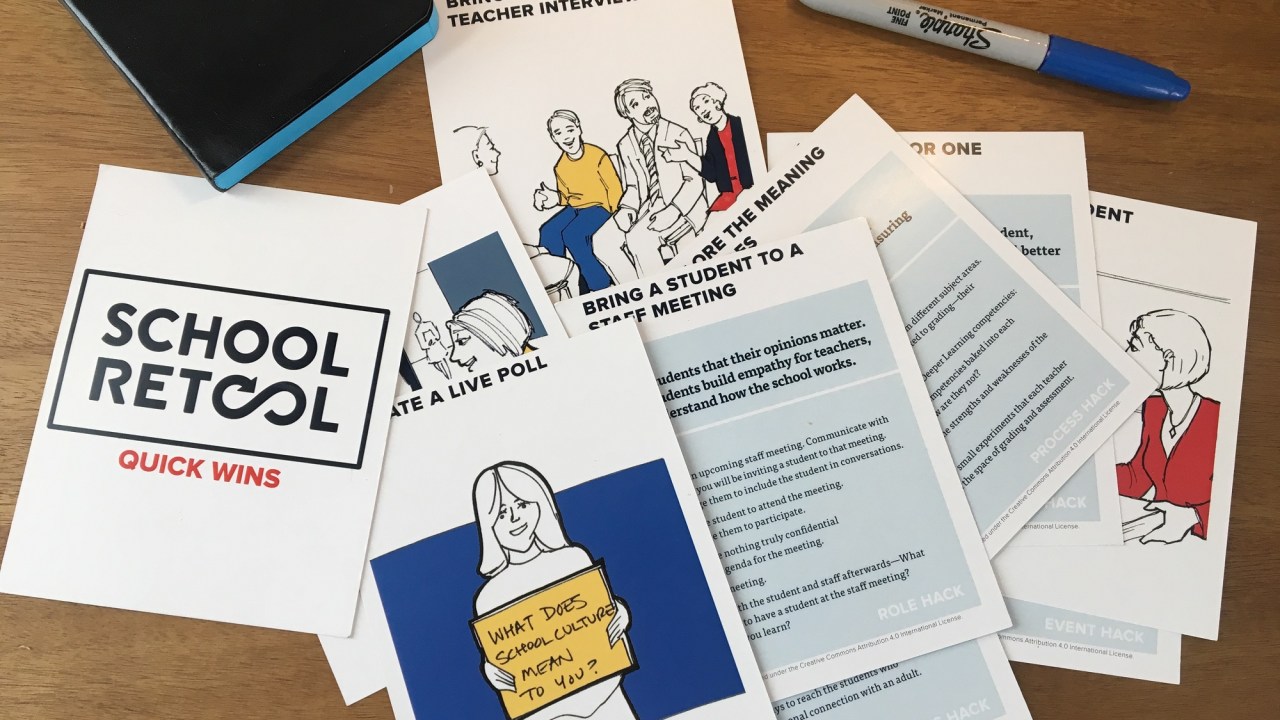
This post originally appeared on Design Thinking for Museums and is republished here with permission.

Last spring and this winter, I’ve had the opportunity to work as a coach for a project called School Retool, an initiative developed by the K12 Lab Network at Stanford’s Hasso Plattner Institute of Design (the d.school) in collaboration with IDEO and the Hewlett Foundation.
School Retool is professional development fellowship that helps public school leaders redesign and transform school culture. The program is grounded in the notion that big change starts small, and by implementing small, scrappy experiments or “hacks,” one can effect large-scale transformation.
To support leaders in catalyzing change, the program introduces them to “Quick Wins”—small things that can be done with little advance planning or budget to build empathy for and connection with end users.
While principals are the “designers” of school culture, museum professionals are the “designers” of the visitor experience, and the key to developing an engaging and human-centered experience is understanding the people for whom you’re designing. These Quick Wins are things you can do next week to flex a “hack mindset,” build deeper empathy for visitors, and understand what resonates with them so that you can design better exhibitions, services, programs, and products.
 1) Relocate your desk for a day
1) Relocate your desk for a day
This is one of the most popular Quick Wins with school leaders in the School Retool program. The principals I worked with moved their desks into the hallways of their schools and found it to be an eye-opening experience. They saw, heard, felt, and even smelled their schools from a completely new perspective.
For museums professionals, this can be achieved by setting oneself up to work for a day, half day, or even a few hours, in a cafe or other public space.
WHY
Experience your museum from a different point of view and gain empathy and insights through observing and listening to visitors.
HOW
- Set aside a few hours to a full day when you don’t have meetings. Think of it as an opportunity to get work done without usual interruptions.
- Choose a public space (museum cafe, a public seating area, or even the information desk).
- Grab your laptop or reading materials and settle in.
- Take in everything that happens in the space throughout the day with all of your senses—listen, watch, feel, and even smell!
- Reflect on what you noticed and learned at the end of the day (it’s important to do this within a couple of days so you don’t forget).
 2) Run a live poll
2) Run a live poll
Museum professionals can use this as an opportunity to get real-time feedback on topics ranging from visitor amenities to upcoming programmatic content. But don’t approach this as you would a market research exit survey; think of this as an opportunity to have meaningful, face-to-face conversations with a handful of real visitors.
WHY
Capture the pulse of your visitors, and make yourself the face of your institution—one that is accessible and open to feedback.
HOW
- Find a colleague to join you—it’s easier to capture feedback with a partner who can take notes.
- Consider offering something to thank visitors, such as note cards, posters, free passes, or other small gifts.
- Choose a question or subject area you’d like to explore through the lens of your visitors.
- Write the question on a small signboard, and stand in the atrium, cafe, information desk, or other high-traffic areas.
- Invite visitors to answer the question. You can capture their feedback in a variety of ways: take notes on Post-its and post them; capture notes on an iPad, or even create audio recordings on your phone.
- Compile the answers, and share them with your staff and visitors.
 3) Take a visitor to coffee
3) Take a visitor to coffee
The thought of asking a random visitor to have coffee with you may seem terrifying at first, but when framed as a chance to share their expertise and personal experiences—and potentially impact the future of the museum—most visitors are delighted to talk and have someone really listen to them.
WHY
Having a face-to-face, unscripted conversation with a visitor (or visitors) over a drink is an invaluable way to learn more about who they are as people and gain insights into their needs and expectations.
HOW
- Assemble your supplies: notebook; pen; staff badge (so they know you are legit); and any incentives you can offer (free passes, gift card, coupons, etc.)
- Park yourself somewhere conducive to intercepting people (near benches, outside the cafe, in the store). It’s fine to meet with more than one person at a time (a couple, for example).
- Offer the incentive and a drink in exchange for a half hour of their time.
- Focus on listening. What is their experience like in your museum? What are their hopes and dreams — in and outside of the museum context?
- Take notes. Take photos with permission (you may want to bring photography permission forms if you have them).
- Reflect on what you heard. Did you hear anything unexpected? What opportunities are there for change?
 4) Shadow a visitor
4) Shadow a visitor
The companion project to School Retool is the national Shadow a Student challenge, an immersion journey that ask principals to experience their schools through students’ eyes, capturing observations and then reflecting and acting on them. The shadow experience is a game-changing and humbling experience for school leaders and can be the same for museum professionals.
WHY
Ethnographers, educators, and researchers have long known the power of shadowing to build empathy and arrive at insights. Shadowing someone and experiencing their joys and frustrations can increase empathy and uncover insights in a relatively short amount of time.
HOW
- Recruit a colleague to join you. It’s helpful to have a second person to observe and take notes.
- Set aside time and block off your schedule.
- Assemble your supplies: comfortable shoes; smartphone; notebook; pen; gifts/incentives for visitors (passes, gift cards, coupons); photo permission forms.
- You can either intercept visitors as they arrive and ask to shadow their visit, or, pre-arrange it in advance and meet them before they start their journey. Shadowing a visitor’s journey to the museum can be extremely powerful, although this takes more advance planning and preparation.There are many ways to pre-arrange this: you can call a local hotel concierge during the run of a popular exhibition and offer free tickets to a guest who will allow you to shadow her/him; you can pre-recruit visitors through websites like Craigslist or NextDoor.com (again, you may want to offer free tickets or other incentives); or you can pre-recruit through word-of-mouth in your neighborhood, through a child’s school, or at a local gym or community center.
- If the visitor will be taking public transportation to the museum, meet them at the train station or bus stop and ride along.
- Adopt a “beginner’s mind.” You will learn the most by having beginner’s eyes and putting your expectations aside. Resist the urge to answer questions that arise during the visit about logistics or content; don’t be an expert.
- Capture what you see and hear.
- Make time for reflection shortly after the visit is over. Consider:
- What did you see and hear?
- How did it feel to be with the visitor?
- What surprised you? What does this make you wonder?
Conclusion
These Quick Wins, adapted from the national School Retool fellowship, are small hacks that museum professionals can implement as ways to gain deeper empathy for museum visitors. And deeper empathy can lead to a better visitor experience because by truly knowing our visitors, we can create better exhibitions, services, programs, and products for them.
These small wins are meant to lead to larger changes in institutional programs, policies, and strategies by uncovering insights into what visitors think, feel, and do. They don’t require extensive advance planning, endless meetings, and significant budget. Let us know if you try one of these Quick Wins by sharing your experience through the feedback form below or with @AAMers and @dmitroff on Twitter.
About the Author
Dana Mitroff Silvers is a design thinking facilitator and digital experience strategist with experience launching innovative products and services in organizations ranging from art museums to educational technology startups. She runs the San Francisco Bay Area-based innovation consultancy Designing Insights LLC and the resource site Design Thinking for Museums. Her clients include the Getty, National Gallery of Art, Smithsonian National Air & Space Museum, Oakland Museum of California, and Denver Museum of Nature & Science. She is a regular speaker and facilitator at national and international museum conferences and a coach and facilitator for the Stanford d.school K12 Lab Network. The former head of digital at the San Francisco Museum of Modern Art, she oversaw the research, development, design, and production of the museum’s award-winning website for over 10 years.








